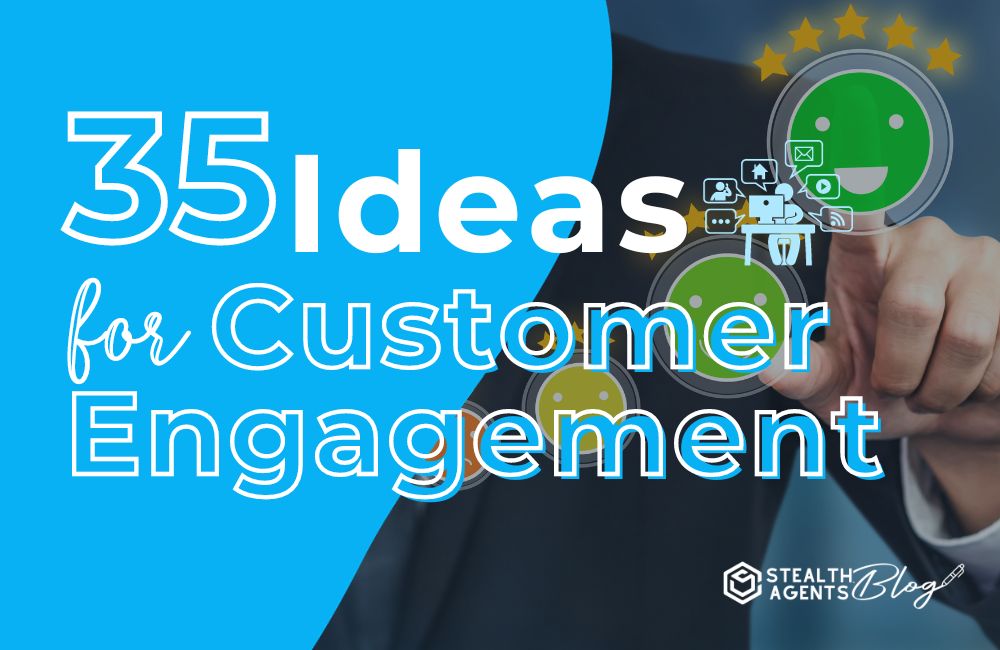Ideas for customer engagement are pivotal for businesses eager to excel in today’s competitive landscape.
Companies with an effective customer engagement strategy often see performance improvements of up to 202%. As you delve into these ideas, you’ll uncover customer engagement improvement phrases that boost satisfaction and demonstrate professionalism.
Executives and entrepreneurs can use these strategies to strengthen their customer relationships effectively. Remarkably, businesses employing robust engagement tactics witness revenue growth of up to 23%.
Stealth Agents supports your journey by offering free consultations on client preferences and virtual assistant pricing to enhance your customer engagement efforts with our expert virtual assistants.
How Can You Improve Customer Engagement?
Improving customer engagement begins with understanding your audience’s needs and preferences to tailor your interactions effectively. Implementing personalized communication and leveraging data analytics can create more relevant and meaningful experiences, thereby increasing productivity.
Exploring diverse ideas for customer engagement allows businesses to increase productivity and foster deeper connections with their clients. By embracing digital tools and platforms, companies can offer seamless and interactive experiences that resonate with modern consumers, often with the help of an outsourced personal assistant.
Consistently seeking feedback and acting on it helps refine your approach and demonstrates your commitment to customer satisfaction.
Incorporating ideas for customer engagement, such as loyalty programs and exclusive content access, can significantly boost retention and brand loyalty.
Ultimately, a well-rounded strategy that integrates different ideas for customer engagement and leverages an outsourced personal assistant ensures that your business remains competitive and customer-centric.
Effective Customer Engagement Ideas
1. Customer feedback surveys
Clear objectives
- Define specific goals for each survey (product improvement, service enhancement).
- Align questions with these objectives to gather actionable insights.
Timing and frequency
- Time surveys strategically after crucial customer interactions.
- Regularly conduct surveys without overwhelming customers.
Incentives
- Offer incentives like discounts or exclusive content to boost participation.
- Communicate the value of feedback in shaping their experience for effective customer engagement.
Accessible platforms
- Deploy surveys through various channels (email, website, social media).
- Optimize for mobile devices to increase accessibility and customer engagement.
2. Real-time support
Multichannel availability
- Integrate live chat on your website, app, and social media platforms.
- Ensure consistency in support quality across all channels.
Quick response times
- Set benchmarks for response times and resolve issues swiftly.
- Use automated responses to acknowledge queries immediately.
Knowledge base integration
- Connect live chat with a comprehensive knowledge base.
- Equip agents with real-time access to FAQs and troubleshooting guides.
Proactive engagement
- Implement proactive chat triggers based on user behavior.
- Offer assistance before customers need to ask for help.
3. Emotional branding
Storytelling
- Share authentic stories about the brand’s journey and values.
- Highlight customer stories to create relatable connections.
Visual branding
- Use visuals that evoke emotions aligned with brand identity.
- Consistently applying brand colors, fonts, and imagery for recognition may increase customer engagement.
Community engagement
- Foster a sense of community around shared values.
- Communicate with customers on social media sites in a real way.
Personalized communication
- Tailor communication to reflect empathy and understanding.
- Use language that resonates with the emotional tone of your audience.
4. Dynamic pricing
Data analysis
- Utilize customer data to understand purchasing patterns.
- Analyze competitor pricing strategies for benchmarking.
Segmentation
- Implement personalized pricing tiers based on customer segments.
- Consider factors like loyalty, past purchases, and demographics.
Promotions and discounts
- Offer dynamic discounts based on user behavior or preferences.
- Communicate the value proposition of personalized pricing.
Transparency
- Communicate the factors influencing dynamic pricing.
- Provide transparency on how personalized pricing benefits the customer.
5. Responsive web design
Cross-device testing
- Test the website often on several different browsers and devices.
- Prioritize a mobile-first approach for seamless mobile experiences.
User-friendly navigation:
- Ensure intuitive navigation with clear menus and calls to action.
- Optimize loading times to enhance overall responsiveness.
Adaptive content:
- Tailor content presentation based on screen size and orientation.
- Use responsive images and fonts to enhance readability.
Feedback mechanism:
- Incorporate feedback tools to understand user experiences.
- Act on feedback promptly to address any design or usability issues.
6. Geo-targeted campaigns
Location-based analytics
- Use location-based analytics to understand customer demographics.
- Identify high-potential regions for targeted campaigns.
Localized content
- Tailor marketing content to reflect regional preferences.
- Consider language, cultural nuances, and local events.
Promotions and offers
- Offer location-specific promotions or discounts.
- Use geotargeting for timely announcements related to local events.
Feedback collection
- Gather feedback on the effectiveness of geo-targeted campaigns.
- Adjust strategies based on customer responses and engagement.
7. Sustainability initiatives
Transparent communication
- Communicate the brand’s commitment to sustainability.
- Share progress updates on eco-friendly initiatives.
Educational content
- Create content that educates customers about sustainability.
- Showcase the impact of their eco-conscious choices.
Green packaging
- Implement eco-friendly packaging and communicate this to customers.
- Encourage recycling and proper disposal of packaging materials.
Partnerships with NGOs
- Collaborate with environmental organizations for shared initiatives.
- Involve customers in community-based sustainability projects.
8. Chat commerce
Seamless integration
- Integrate chat commerce into existing communication channels.
- Ensure a smooth transition from conversation to transaction.
Secure transactions
- Prioritize secure payment gateways within chat platforms.
- Tell people about the safety steps you’ve implemented to earn their trust.
Product recommendations
- Train chatbots to provide personalized product recommendations.
- Use chat interactions to understand customer preferences.
Real-time order tracking
- Implement features that allow customers to track orders in real-time.
- Provide instant updates on order status through chat.
9. Instant messaging marketing
Permission-based marketing
- Obtain explicit consent before sending marketing messages.
- Communicate the value customers receive through messaging.
Segmentation and personalization
- Segment audiences for targeted messaging.
- Customize messages to align with individual customer preferences and behaviors.
Interactive content
- Integrate interactive elements into messaging content.
- Use messaging platforms for surveys, polls, and contests.
Timing and frequency
- Respect peak usage times and time zones.
- Control messaging frequency to avoid becoming intrusive.
10. Accessibility features
Compliance with standards
- Ensure that your products and services adhere to accessibility standards.
- Regularly audit digital assets for compliance.
User Testing
- Conduct usability testing with individuals with diverse abilities.
- Gather feedback from users with different accessibility needs.
Accessible communication
- Provide alternative formats for content (audio descriptions, transcripts).
- Use clear and straightforward language in communications.
Continuous improvement
- Establish a feedback loop for accessibility concerns.
- Actively work on resolving reported issues promptly.
11. Humanize customer support
Training programs
- Train support teams on empathetic communication.
- Provide scenarios and role-playing exercises for skill development.
Personalizedinteractions
- Use customer names and reference past interactions.
- Allow support agents flexibility in addressing customer needs.
Empowerment and autonomy
- Empower support agents to make decisions to solve customer issues.
- Encourage autonomy in finding creative solutions.
Customer Appreciation
- Express gratitude for customer loyalty.
- Implement initiatives to celebrate customer milestones.
12. Self-service portals
Intuitive design
- Design portals with a focus on simplicity and ease of use.
- Implement straightforward navigation and search functionalities.
Comprehensive FAQs
- Regularly update FAQs based on typical customer queries.
- Provide multimedia resources for varied learning styles.
User feedback integration
- Include feedback mechanisms within self-service portals.
- Act on feedback to continuously improve self-service resources.
Interactive guides
- Develop interactive step-by-step guides for issue resolution.
- Use chatbots to guide users through self-service options.
13. Blockchain for trust
Transparent transactions
- Communicate the use of blockchain in transactions.
- Provide tools for customers to verify blockchain-based records.
Data security
- Highlight how blockchain enhances data security.
- Educate customers on the benefits of decentralized systems.
Blockchain-Based loyalty programs
- Implement blockchain for transparent loyalty point systems.
- Showcase the traceability of rewards through blockchain.
Educational campaigns
- Develop content explaining blockchain technology in simple terms.
- Engage customers in educational campaigns to build understanding.
14. Embrace 5G technology
Optimized content
- Optimize website and app content for faster loading times.
- Leverage 5G capabilities for high-quality multimedia content.
Enhanced experiences
- Explore augmented reality and virtual reality experiences.
- Provide interactive features that capitalize on high-speed connectivity.
Real-time interactions
- Offer real-time customer support features utilizing 5G.
- Use 5G for seamless live streaming and communication.
Continuous innovation
- Stay informed about 5G advancements and possibilities.
- Explore and adopt new technologies as 5G capabilities evolve.
15. Artificial intelligence in recommendations
Behavioral analysis
- Implement AI algorithms to analyze user behavior.
- Use machine learning to predict future preferences.
User feedback loop
- Gather feedback on recommended products.
- Integrate customer reviews and feedback into recommendation algorithms.
Cross-sell and upsell
- Use AI to identify opportunities for cross-selling and upselling.
- Implement personalized offers based on previous interactions.
Regular model updates
- Regularly update recommendation models with new data.
- Collaborate with data scientists to refine algorithms.
16. Voice of Customer (VoC) Programs
Diverse feedback channels
- Collect feedback through surveys, reviews, and social listening.
- Utilize various channels to capture a diverse range of opinions.
Prompt response mechanism
- Acknowledge customer feedback promptly.
- Communicate actions taken based on customer input.
Feedback Integration
- Integrate feedback into product development and service improvements.
- Share success stories based on customer suggestions.
Closed-loop feedback
- Establish a closed-loop system for continuous improvement.
- Regularly review and update customer feedback processes.
17. Augmented customer support
AR training for teams
- Train support teams on using augmented reality tools.
- Familiarize them with AR troubleshooting and assistance.
Visual guides for customers
- Provide customers with AR visual guides for issue resolution.
- Incorporate AR tutorials into self-service resources.
Feedback mechanism
- Collect feedback on the effectiveness of AR support.
- Use customer insights to refine and improve AR applications.
Continuous training
- Stay updated on the latest AR advancements and features.
- Regularly train support teams on new AR tools and capabilities.
18. Social commerce integration
Seamless shopping experience
- Integrate a secure and user-friendly shopping experience on social media.
- Optimize product displays for easy navigation and purchasing.
Promotional content
- Share exclusive promotions and product launches on social platforms.
- Leverage social commerce for limited-time offers and flash sales.
Customer engagement
- Get people to post about their purchases on social media.
- Use social commerce as a platform for customer interactions and feedback.
Analytics and optimization
- Use analytics to understand customer behavior within social commerce.
- Continuously optimize the shopping experience based on insights.
19. Dynamic content personalization
Real-Time analytics
- Utilize real-time analytics to understand user behavior.
- Tailor content based on current user interactions.
User Journey mapping
- Map out different user journeys and touchpoints.
- Personalize content to align with specific stages of the customer journey.
A/B testing:
- To identify the most effective personalization strategies, execute A/B testing.
- Regularly iterate and refine content based on testing results.
User preferences management
- allows users to manage and update their preferences.
- Seek explicit consent before implementing personalized content strategies.
20. Strategic partnerships
Aligned values
- Identify partners with similar values and customer demographics.
- Ensure a strategic fit for mutual benefits.
Collaborative campaigns
- Plan joint marketing campaigns and promotions.
- Leverage each other’s strengths for a comprehensive reach.
Co-creation
- Explore opportunities for co-creating products or services.
- Involve customers in the co-creation process for added engagement.
Exclusive offers
- Offer exclusive discounts or perks for customers from partner brands.
- Communicate the added value of the partnership to customers.
21. Cybersecurity measures
Secure transactions
- Implement SSL certificates for secure online transactions.
- To avoid possible threats, keep your security measures up to date.
Customer education
- Educate customers about cybersecurity best practices.
- Provide resources on recognizing and reporting suspicious activities.
Privacy policies
- Communicate your privacy policies to customers.
- Regularly update and review privacy policy documents to engage more customers.
Incident response plan
- Make a firm plan for what to do if there is a hacking breach.
- Communicate transparently with customers in the event of a security incident.
22. Continuous learning and adaptation
Industry research
- Stay informed about industry trends through continuous research.
- Monitor competitors and emerging technologies in your sector.
Internal training programs
- Conduct regular training sessions for teams on industry advancements.
- Encourage everyone in the company to keep learning.
Feedback mechanisms
- Encourage teams to provide feedback on industry trends.
- Actively seek customer feedback on evolving needs and expectations.
Agile strategy implementation
- Be agile in adapting strategies based on new insights.
- Accept that you can always do better and come up with new ideas.
23. Personalized customer experiences
Dynamic personalization
- Use real-time data to personalize user experiences dynamically.
- Implement algorithms that adapt to changing customer behaviors.
Preference management
- Allow customers to manage their preferences easily.
- Provide options for them to update preferences at any time.
Feedback loop
- Encourage customers to provide feedback on personalized experiences.
- Use feedback to refine and enhance personalization strategies.
24. AI-powered chatbots
Continuous Learning
- Regularly update chatbots with new information and responses.
- Implement machine learning algorithms for continuous learning.
Human Handover Feature
- Enable seamless handovers to human agents when needed.
- Ensure a smooth transition between chatbot and human support.
Proactive Assistance
- Use AI to identify potential issues and offer assistance proactively.
- Anticipate user needs based on historical interactions.
25. Social media listening
Sentiment Analysis
- Implement sentiment analysis tools to gauge customer sentiment.
- Identify patterns and trends in social media discussions.
Engagement strategy
- Develop a proactive engagement strategy based on social media insights.
- Respond promptly to positive interactions and address concerns.
Social listening tools
- Invest in advanced social listening tools for real-time monitoring.
- Integrate tools that provide comprehensive analytics and insights.
26. Video tutorials and demonstrations
Interactive elements
- Include interactive elements within video content.
- Allow viewers to click for additional information or participate in polls.
User-generated content
- Encourage customers to share their video tutorials.
- Showcase user-generated content as part of your video strategy.
Metrics and analytics
- Track viewer engagement metrics (views, watch time, interactions).
- Use analytics to optimize future video content based on performance.
27. Interactive content
Gamified content
- Integrate gamification into interactive content.
- Create quizzes and challenges to enhance engagement.
Data collection
- Use interactive content for subtle data collection.
- Gain insights into customer preferences through interactive elements to increase customer engagement.
Responsive design
- Ensure interactive content is accessible on various devices.
- Optimize for mobile to capture on-the-go engagement.
28. Subscription services
Tiered membership:
- Implement tiered membership levels with escalating benefits.
- Communicate the advantages of each subscription tier.
Surprise rewards:
- Occasionally offer surprise rewards or exclusive content.
- Keep subscribers engaged with unexpected perks.
Cancellation feedback:
- Gather feedback when customers cancel subscriptions.
- Use insights to enhance subscription offerings.
29. Gamification
Leaderboards and challenges
- Introduce leaderboards and challenges for users.
- Create a friendly competition to drive engagement.
Reward systems
- Establish a comprehensive reward system tied to gamification.
- Offer tangible incentives for reaching certain milestones.
Feedback loops
- Use gamification feedback loops for continuous improvement.
- Adapt challenges and rewards based on user responses.
30. Virtual events
Post-event content
- Share highlights and recorded sessions after the event.
- Extend the lifespan of the virtual event through ongoing content.
Audience interaction
- Facilitate audience interaction through live Q&A sessions.
- Encourage participants to submit questions and comments.
Post-event surveys
- Collect feedback through post-event surveys.
- Analyze responses to improve future virtual events.
What Makes a Good Engagement Strategy?
A good engagement strategy centers around understanding and addressing your audience’s unique needs and preferences. Personalization is crucial, allowing businesses to tailor their interactions and offers, making customers feel valued and understood.
Effective communication is another critical component, ensuring a transparent, open dialogue between the brand and its customers.
Innovation in executing these ideas for customer engagement keeps the strategy fresh and exciting, encouraging customers to interact more frequently. Analyzing data and feedback helps refine these strategies, ensuring they remain relevant and impactful.
By consistently applying these ideas for customer engagement, businesses can foster deeper relationships, build rapport, and enhance customer loyalty.
Ultimately, a successful engagement strategy turns customers into advocates who passionately support and promote the brand.
Takeaways
Customer engagement is the cornerstone of thriving businesses. In exploring these 30 ideas for customer engagement, it’s clear that innovation and personalization are vital in nurturing strong relationships. Each idea provides a unique opportunity to connect with customers on a deeper level, fostering loyalty and satisfaction.
By implementing these strategies, companies can retain existing clients and attract new ones who appreciate a brand’s commitment to exceptional service. The digital age offers various tools to enhance customer interactions, allowing seamless communication and personalized experiences.
As businesses continue to evolve, embracing these ideas for customer engagement can set them apart in a competitive marketplace. Consistent engagement not only boosts sales but also transforms customers into brand advocates.
To amplify these efforts, consider leveraging virtual assistant services from Stealth Agents, ensuring your business remains at the forefront of customer engagement excellence.










